
Navigating LinkedIn Campaign Manager's Ad Performance Dashboard


When running LinkedIn Ads, it’s important to know how those ads are performing. LinkedIn’s Campaign Manager is not only where you go to create and manage ads, but is also where you can view performance metrics at both the campaign and ad levels.
LinkedIn Campaign Manager’s dashboard offers a great overview of ad performance at the default view, but there are several ways you can filter and customize this dashboard in order to draw deeper insights. There are also some precautions to be aware of when it comes to the way LinkedIn reports on some metrics.
We’re covering all of these things in detail in this week’s post. Read on! 📖🤓
LAYOUT
When clicking into your LinkedIn Ads account, this is the default view of the performance dashboard 👇
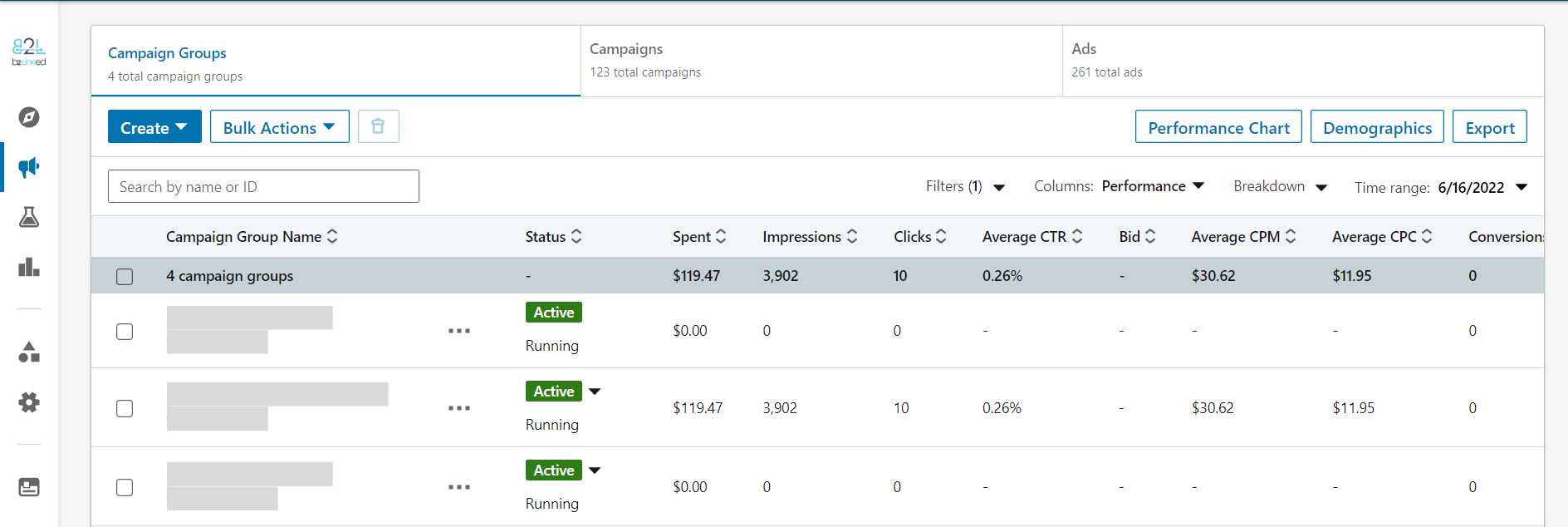
Let’s discuss each part from top to bottom.
In the top section, you’ll notice there are three levels at which you can drill down performance: Campaign Groups, Campaigns, and Ads.
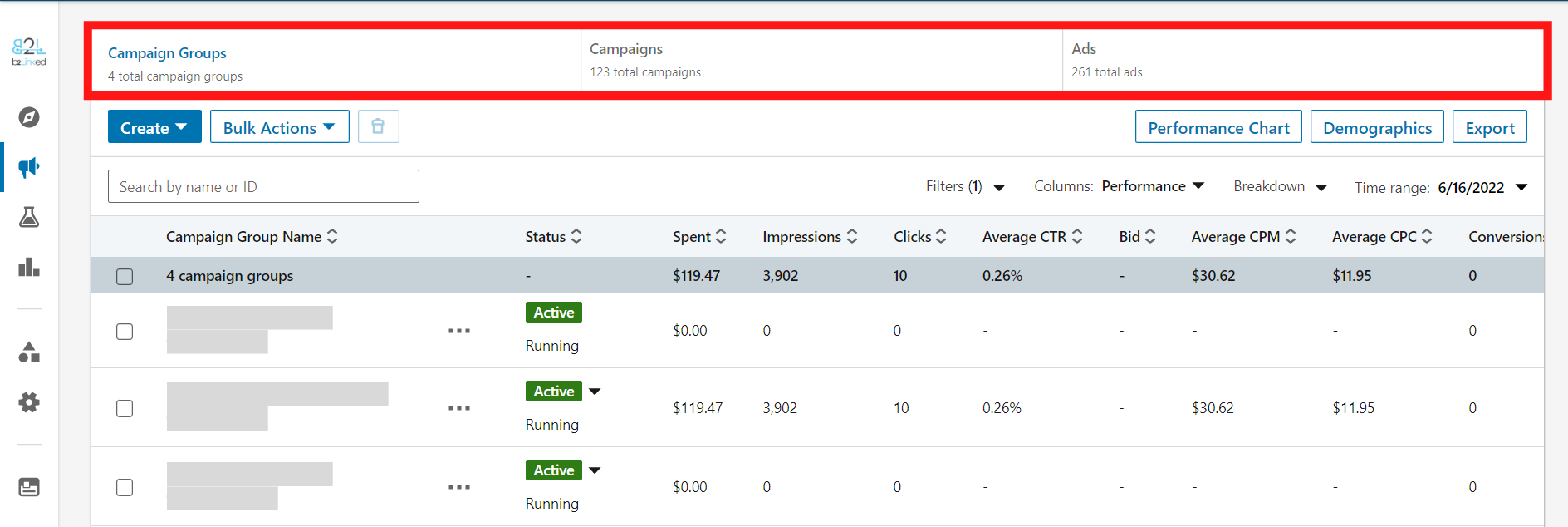
Similar to other digital ad platforms, like Google and Facebook, there are varying levels at which you can manage your ads.
Within every account, you’ll have at least one campaign group; within every campaign group, you might have several campaigns; and then within every campaign, you may have several ads.
You can view ad performance at each of these levels by either clicking on the level itself or, if you want to view specific campaigns or ads, click on the campaign group(s) and campaign(s) names you wish to drill down into.
The next section gives us options to create and manage campaigns and ads, as well as other methods of viewing ad performance.

On the left, we can create new campaigns, campaign groups, and accounts from the “Create” button. We can also edit campaigns and campaign groups in bulk from the “Bulk Actions” dropdown.
The trash icon can be used to delete active campaigns, campaign groups, and ads when the checkboxes next to those items’ names are selected.
To the right, we can view trends in ad performance through the Performance Chart button and see native demographic data on our target audience through the Demographics button. We won’t go into much detail on these two features in this post (as there’s a lot to them), but we have podcast episodes going over both. Feel free to check them out below!
Analyzing LinkedIn Ad Performance Trends Over Time with the Performance Chart Feature
Free Analytics and Demographics Tool on LinkedIn Ads
The last button on the right is the “Export” button, which allows you to download and view ad performance results through a spreadsheet. With this option, you can create pivot tables and filter data for even deeper insights.
The third section is where we can change the view of our dashboard.
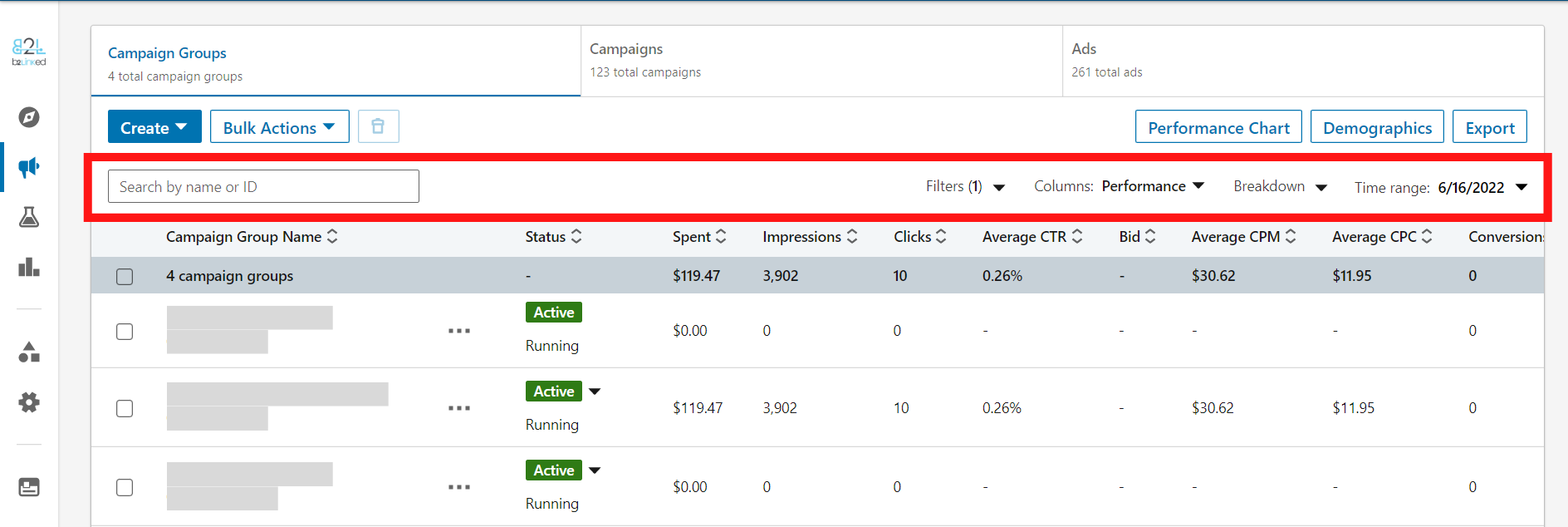
Depending on what you change in this section will determine what will be changed in the following section, which is where you can view your listed campaign groups, campaigns, and ads (depending on which level you’re viewing) and their associated performance metrics.
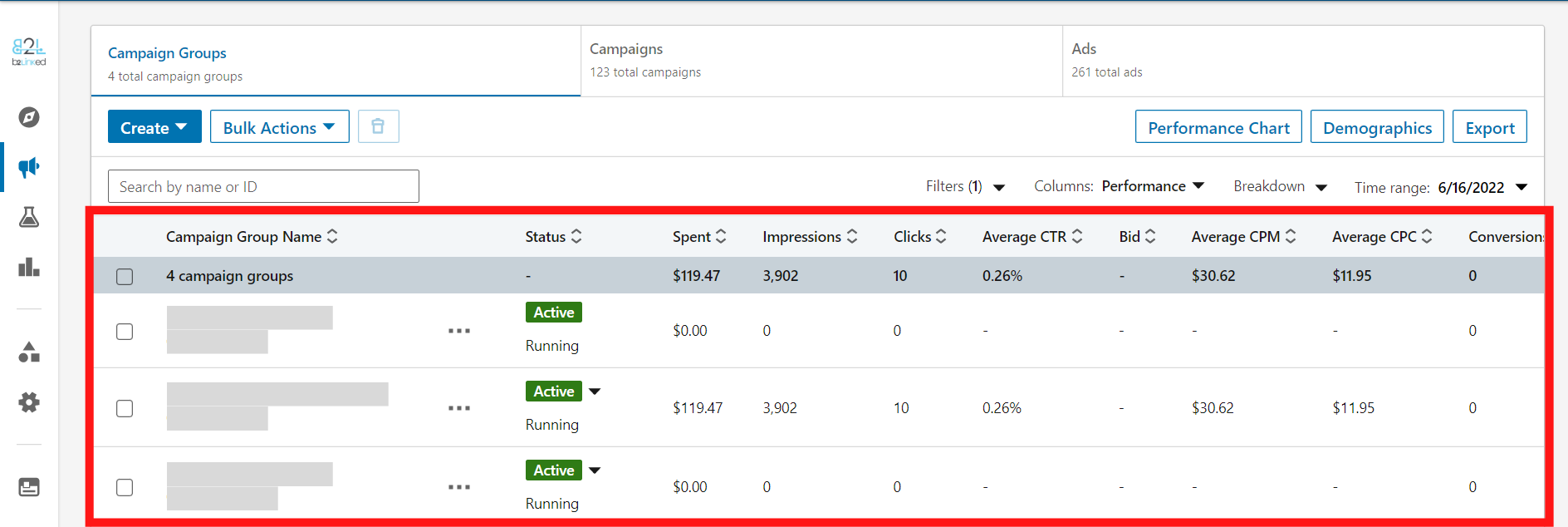
Let’s dive into detail on what exactly we can do in the third section of the LinkedIn performance dashboard.
SEARCH BAR
Here you can search for campaigns, campaign groups, and ads (depending on which level you’re viewing) by name or by ID. LinkedIn Campaign Manager’s Search feature is really good, as it pulls up search queries quickly and filters down your entire view based on your queries almost immediately.
COLUMNS
By clicking the “Columns” dropdown, you can change the metrics displayed in your dashboard by selecting from the list. Here’s what metrics are available depending on which option you select:
PERFORMANCE
This is the default view when logging into LinkedIn Campaign Manager. Metrics displayed are:
- Status
- Spent
- Key Results
- Cost per Result
- Impressions
- Clicks
- Average CTR
- Bid
- Average CPM
- Average CPC
- Conversions
- Cost per Conversion
- Leads
- Cost per Lead
- Event Registrations
DELIVERY
This view is best optimized for metrics related to Reach and Frequency. Metrics displayed are:
- Status
- Spent
- Key Results
- Cost per Result
- Impressions
- Reach
- Average Frequency
- Average CPM
- Cost per 1,000 Member Accounts Reached
ENGAGEMENT
This view is best optimized for metrics related to social proof, such as Reactions, Comments, and Shares. Metrics displayed are:
- Status
- Spent
- Key Results
- Cost per Result
- Impressions
- Clicks
- Average CTR
- Reactions
- Comments
- Shares
- Follows
- Other
- Total Social Actions
- Clicks to Landing Page
- Clicks to LinkedIn Page
- Total Engagement
- Engagement Rate
CONVERSIONS & LEADS
This view is best optimized for metrics related to Conversions and Leads. Metrics displayed are:
- Status
- Spent
- Key Results
- Cost per Result
- Impressions
- Clicks
- Conversions
- Click Conversions
- View Conversions
- Conversion Rate
- Cost per Conversion
- Total Conversion Value
- Return on Ad Spend
- Leads
- Lead Form Opens
- Lead Form Completion Rate
- Cost per Lead
- Event Registrations
- Click Event Registrations
- View Event Registrations
SPONSORED MESSAGING
This view is best optimized for campaigns that are running the Sponsored Messaging ad type. Metrics displayed are:
- Status
- Spent
- Key Results
- Cost per Result
- Sends
- Opens
- Sponsored Messaging Clicks
- Button Clicks
- Banner Clicks
- Link Clicks
- Open Rate
- Click to Open Rate
- Cost per Send
- Cost per Open
- Average CPC
VIDEO
This view is best optimized for campaigns that are running the Video ad type. Metrics displayed are:
- Status
- Spent
- Key Results
- Cost per Result
- Impressions
- Clicks
- Average CTR
- Views
- View Rate
- eCPV (Estimated Cost per View)
- Views @ 25%
- Views @ 50%
- Views @ 75%
- Completions
- Completion Rate
- Full Screen Plays
BUDGET & BID
This view is best optimized for metrics related to how much you’re budgeting and bidding. Metrics displayed are:
- Status
- Spent
- Key Results
- Cost per Result
- Total Budget
- Avg. Daily Spend
- Daily Budget
- Bid
- Start Date
- End Date
TALENT LEADS
This view is best optimized for campaigns that are running the Talent Leads objective. Note that this objective is only available to those with a LinkedIn Recruiter License. Metrics displayed are:
- Status
- Spent
- Key Results
- Cost per Result
- Impressions
- Clicks
- Talent Leads
- Talent Lead Rate
- Cost per Talent Lead
JOB APPLICANTS
This view is best optimized for campaigns that are running the Job Applicants objective. Metrics displayed are:
- Status
- Spent
- Key Results
- Cost per Result
- Impressions
- Clicks
- Job Apply Clicks
- Job Applications
- Job Application Rate
- Cost per Job Application
CUSTOM COLUMNS
In addition to these premade columns, you can also choose to create a custom view. To do so, under the “Columns” dropdown, click “Customize Columns”.
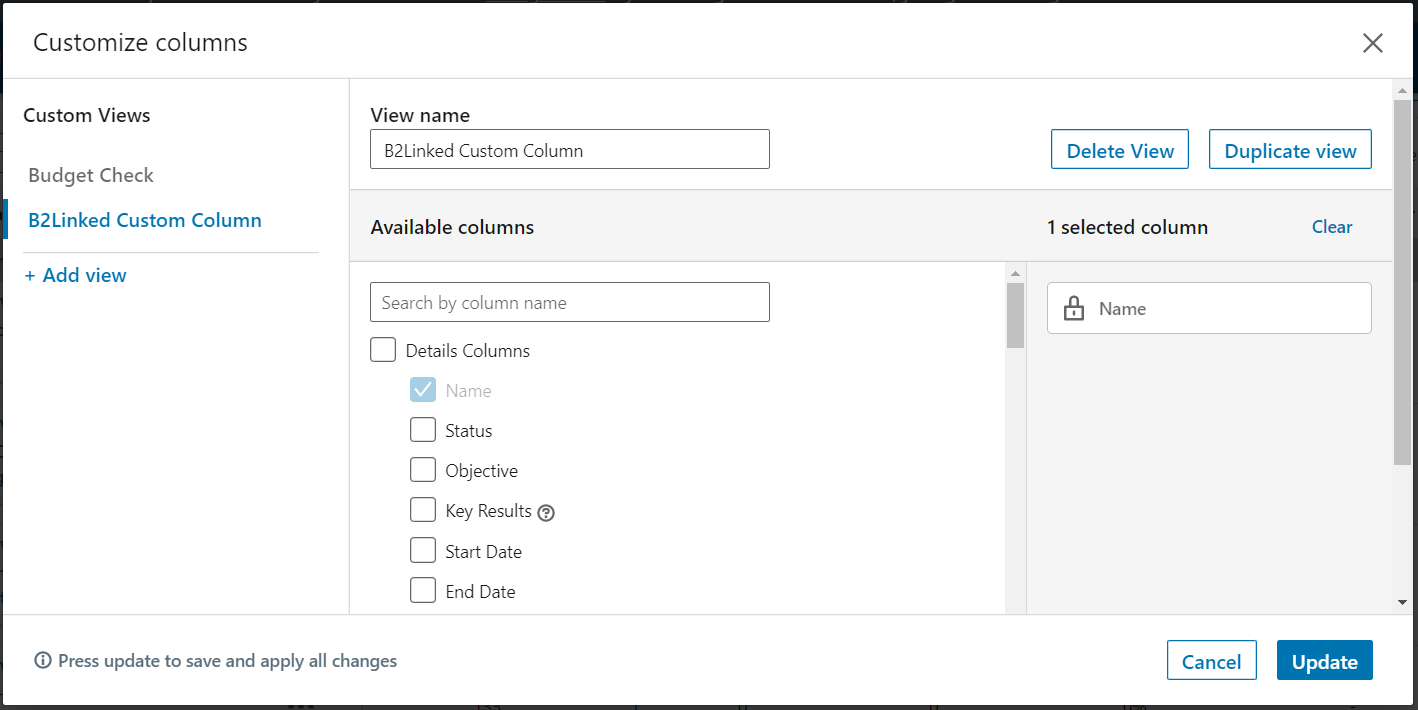
From here, you can name your view and add any metrics you’d like to see when this view is selected. Once finished customizing your view, click “Update”.

BREAKDOWN
The Breakdown menu allows you to drill down into select metrics even further. For example, by clicking “Conversions”, if any of your campaign groups, campaigns, or ads generated conversions, this view allows you to see the names of the conversions that were generated, how many, and to which campaign groups, campaigns, or ads they were attributed to.
The On/Off Network option allows you to see whether or not certain metrics were generated on or off the LinkedIn platform. These metrics are tracked depending on whether or not you’re leveraging LinkedIn’s Audience Network feature.
The Carousel option allows you to see a breakdown of performance by carousel card.
To remove these drill-down filters, click “Clear” in the dropdown menu.
FILTERS
This feature allows you to filter ad performance around three different criteria: Status, Ad Type, and Campaign Objective. From the dropdown menu, check the boxes of the criteria that you’d like to view.
This feature is especially helpful if, for example, you only want to view Active campaigns or ads of a certain Ad Type.
PRECAUTIONS
LinkedIn Ads can be a confusing platform to get down but it certainly doesn’t help when LinkedIn adds to the confusion by the way it chooses to report on certain metrics.
Now that we’ve covered how to navigate the LinkedIn performance dashboard, let’s talk about some precautions to take when analyzing your performance data.
SPONSORED MESSAGING ADS
Unless you’re looking over ad performance for your Sponsored Messaging ads using the Sponsored Messaging view, the metrics displayed are going to be a little deceiving.
For example, in any other views, the Impressions metric actually represents the Sends metric in the Sponsored Messaging view. Likewise, the Clicks metric actually represents the Opens metric.
Because of this, it’s always best to view performance metrics for your Sponsored Messaging ads using the Sponsored Messaging view.
COMBINED CONVERSIONS
When looking at the Conversions metric, unless you’re looking at the Click Conversion and View Conversion metrics separately, LinkedIn is going to combine both into one number. Most advertisers care to only see the Click Conversion metric, as it’s directly attributable to LinkedIn Ad efforts (View Conversions are counted when someone sees your ad, doesn’t click, but converts off-platform).
View Conversions can still be valuable in measuring, but if you care more about Click Conversions, the nature of the generic Conversions metric can be misleading.
CONCLUSION
Understanding your LinkedIn Ad performance data is key in being able to make optimizations. The filters and tools available to you in LinkedIn Campaign Manager make reading and digesting your performance data easier.
Were there any details or precautions we missed? Feel free to leave a comment below!
Also, if you can’t already tell, we really dig this stuff. 😉 In the 8 years we’ve run LinkedIn Ads, we’ve spent $150M+ on the platform, are official LinkedIn Marketing Partners, and have managed some of the largest LinkedIn Ad accounts in the world.
B2Linked increases your lead quality while lowering costs at the same time. Say goodbye to wasted ad spend! If you want to ramp up your LinkedIn Ad efforts, apply to work with our team of experts.
Thanks for reading and happy advertising!
Written by Eric Jones
